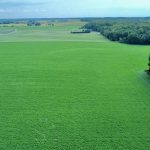LANDMARK, Man. – Hog production is still going full-steam at Marg Rempel’s farm, as is the flow of red ink.
Because so few details are available about new federal hog industry aid programs, Rempel is putting off until Christmas the agonizing decision about whether to close the barns on her 500-sow, farrow-to-finish operation.
“By the end of the year, I’m going to have to make the decision,” said Rempel, sitting at her dinner table as she examined her options and found none to be attractive.
Read Also

Forecast leans toward cooling trend
July saw below average temperatures, August came in with near to slightly above average temperatures and September built on this warming trend with well above average temperatures for the month.
If she decides to shut down the hog barns, the farm that she runs with her son Jason and three full-time employees will become a sideline for the family.
“It would be just myself and my son working part time here and relying on off-farm jobs,” said Rempel, who owns 1,600 acres of cropland.
She’s losing $300,000 per year and the rational part of her mind tells her shutting down might make the most sense. But then she would have to lay off her workers, one of whom has been working at the farm for 30 years, and stop contributing to her community.
“I’ll make a lot of sacrifices in order to be able to continue to provide employment,” said Rempel, a former chair of the Canadian Foodgrains Bank.
“I farm because I love to farm. I’m strongly (convinced) that primary food production is the most important job in the world. That’s my bottom line.”
Rempel’s situation is common in eastern Manitoba’s Red River Valley. Dozens of hog barns have sprung up in the region in the past decade, many dedicated solely to producing weanlings to sell to Midwest American farmers.
The weanling export industry is in freefall because country-of-origin labelling has effectively shut the U.S. market. However, farrow-to-finish operations such as Rempel’s are also common, relying on the Canadian slaughter industry to process their pigs and pay them a competitive price.
Rempel doesn’t face a closed U.S. market, so the crisis on her farm isn’t as extreme as on a weanling operation, which depends on shipping to the United States. But she’s facing a long, slow drain of equity that is crippling the industry across Canada as negative margins create a third year of losses.
Many farmers were damaged by the collapse of hog prices in late 1998, but by mid-1999 prices had recovered and farmers were able to begin paying back the short, sharp losses of those few months.
Rempel said her farm had recovered most of its equity by 2003-04 and was in a good position. That year her husband, Ron, died, leaving her with a personal tragedy and a crucial choice: should she keep operating the farm?
Rempel decided she could keep the mixed farm going by adding Ron’s tasks to her own, giving herself 18 to 20 hour days for a couple years. However, she, her son and their employees worked out how to manage the farm’s new reality and settled into a less onerous work life.
Then grain prices and the Canadian dollar rose and hog prices stumbled, causing negative margins to again eat away at the equity.
Rempel married her husband in 1974 and moved onto the farm. The couple took over Ron’s parents’ farm two years later. They expanded their hog operations early and had paid off a lot of debt by the time margins slumped in 1998 and 2007. As a result, they weren’t financially crippled like young or new producers who had recently bought or built hog farms with borrowed money.
However, that financial soundness is part of why Rempel is in the situation she now faces: she wasn’t forced to act quickly.
“To have made the decision early in the process to cut the losses and get out would, in hindsight, have been a better decision,” she said.
“But those of us who have been farming for a long time had some equity to play with and we have seen these ups and downs before. People thought, ‘I can’t go on losing $30 a pig forever. It’s got to get better. I can make it through the first year; I can make it through the second year,’ ” she said.
“So you end up maxing out your line of credit. You’re paying your bills slower and slower and slower. Then it’s a harder decision to get out because you’ll have nothing.”
Selling a hog barn in southeastern Manitoba today isn’t easy and wouldn’t pay off many debts.
“With dozens of empty hog barns in southern Manitoba, what’s the value of my barn?” Rempel said.
Analysts expect profitable hog prices to arrive next spring, offering hope to farmers like Rempel.
However, she knows she’ll have to be realistic about the decision at the end of 2009 and do what’s best for herself and her family.
If she can find a way to keep operating and keep herself, Jason and the three workers fully employed, she will.
Jason has often worked off the farm, but he wants a career on the farm and hopes to make it through this crisis.
“I’ve tried many other things, but I keep getting drawn back to farming,” the 32-year-old said as he unloaded barley.
“It gets in your blood. It gets in your bones. It’s something I enjoy doing.”
If the family farm can survive this downturn, maybe hog production will continue to be central to its income. Perhaps they’ll have to take on another form of food production as well. Right now, survival is the only concern.
“We’re going to try to get through this cycle and then be able to make the next decision,” Jason said.















